10 Do-At-Home Tests to Check If Your Kitchen Ingredients Are Adulterated
Long supply chains and grocery stores selling loose ingredients make it impossible to track where the food comes from or what sub-standard material is mixed in it. However, there is help at hand.

Indian kitchens use a variety of ingredients in everyday life. Unfortunately, in recent years, the purity of these ingredients have become a matter of concern. A simple search on Google shows multiple news reports of adulteration in commonly consumed food items like spices, oil, milk, ghee, sugar etc.

Long supply chains and grocery stores selling loose ingredients make it impossible to track where the food comes from or what sub-standard material is mixed in it. However, there is help at hand.
Here are some quick and easy-to-perform tests that can reveal the presence of common adulterants in your kitchen cabinet.
1. Spices

With the ability to transform any dish, spices are indispensable for every Indian kitchen. Distressingly, powdered spices available in the market are often contaminated with artificial colours and bulking agents (like chalk powder) that have serious health implications for consumers.
- Turmeric Powder
Adulterant: Metanil yellow, lead chromate, chalk powder
Test: Take some turmeric powder in a transparent glass and add a few drops of water and concentrated hydrochloric acid to it. Next, shake it vigorously. A pink colour to the mixture indicates the presence of metanil yellow. If the mixture releases small bubbles, it indicates the presence of chalk powder.
To detect the presence of lead chromate, mix a teaspoon of turmeric powder with water. If adulterated, it will immediately leak streaks of water-soluble colour.
One of the easiest ways to check adulteration is to add a teaspoon of turmeric to a glass of warm water. Do not stir it and leave it still for a while. Check after about 20 minutes. If the powder settles down at the bottom of the glass with clear water above, the turmeric is pure. Cloudy water indicates possible adulteration.
- Red Chilli Powder
Adulterant: Artificial colour, brick powder
Test: Add a teaspoon of chilli powder to a glass of water and stir it. A swirl of bright red colour indicates the presence of artificial colour while the settling of gritty sediment at the bottom of glass indicates the presence of saw dust/brick powder.
- Coriander Powder
Adulterant: Husk
Test: Add a teaspoon of cumin powder to a glass of water and stir.The husk will immediately start floating on the surface while the pure spice will settle at the bottom of the glass.
- Cumin Seeds/Powder
Adulterant: Grass seeds coloured with charcoal dust, saw dust, starch
Test: Add a teaspoon of cumin powder to a glass of water and let it stay still for a few minutes.The adulterants will float on the surface while the pure spice will settle at the bottom of the glass.
Cumin seeds, on the other hands, are often mixed with grass seeds coated with charcoal dust. Rub the cumin seeds vigorously with your palms. If your palms turn black, it indicates adulteration.
- Black Pepper
Adulterant: Papaya seeds
Test: Add a few pepper corns to a bowl of alcohol. The papaya seeds will sink while the real corns will stay afloat.
- Mustard Seeds
Adulterant: Argemone seeds
Test: Crush or press a few seeds and check them. Argemone seeds have a rough exterior and are white inside while mustard seeds have a smooth exterior and are yellow on the inside.
2. Sugar

Adulterant: Chalk powder
Test: Stir in a spoonful of the salt in a glass of water for a few minutes. If the solution turns white and the residue settles at the bottom, it indicates the presence of chalk. A clear solution indicates purity.
3. Salt
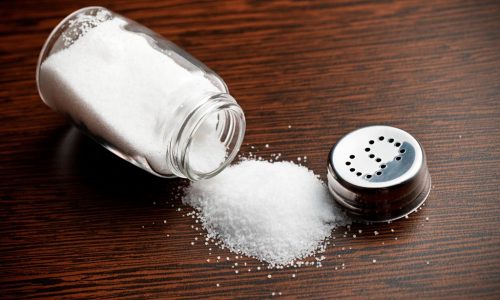
Adulterant: chalk powder
Test: Stir in a spoonful of the salt in a glass of water. If the solution turns white and a residue settles at the bottom, it indicates the presence of chalk. A clear solution indicates purity.
4. Milk/Khoya/Condensed Milk
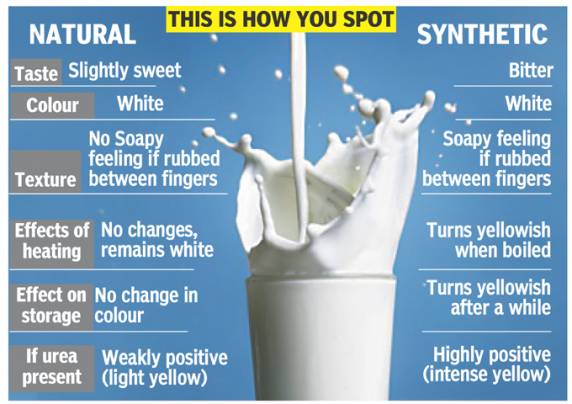
Adulterant: Starch, detergent
Test: Mix a small sample of the product with about 20 ml of water and bring to a boil. Cool to room temperature in a transparent glass and add a drop or two of iodine solution. A blue-coloured solution indicates the presence of starch.
Mix about 10 ml of a milk sample with an equal quantity of water and shake the mixture vigorously. Milk adulterated with detergent will form a dense lather while pure milk will have a thin layer of foam.
5. Butter/Ghee
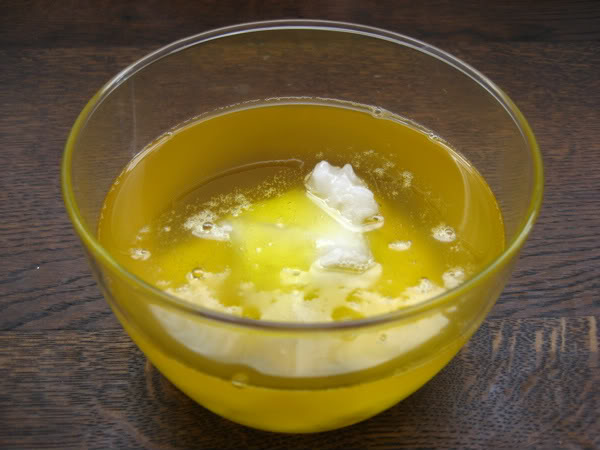
Adulterant: Vanaspati, vegetable oil, starch
Test: Take a teaspoon of melted ghee/butter in the test tube or transparent bottle. Add a pinch of sugar, close the container and give it a vigorous shake. Let it stand for five minutes. If a red colour appears at the bottom of the vessel, then the sample contains vegetable oil.
Melt a small quantity of the ghee/butter. Pour it into a glass jar and place in the fridge till it solidifies. Presence of separate layers indicates the presence of other oils.
Add a few drops of iodine to two teaspoons of molten ghee. Appearance of purple colour indicates the presence of starch (like mashed potato).
6. Oil
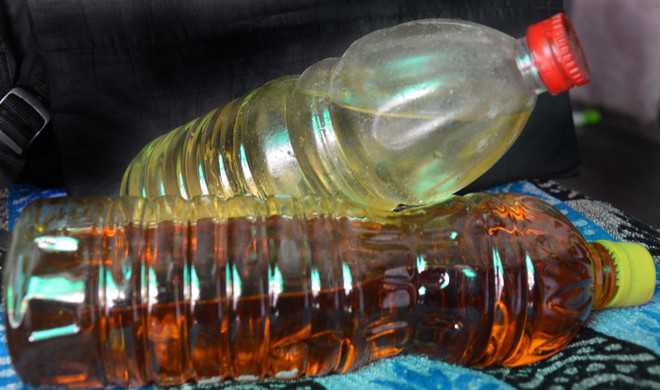
- Mustard Oil
Adulterant: Argemone oil
Test: Take a small amount of mustard oil in a transparent glass and add a few drops of nitric acid to it. Shake vigorously and heat the mixture for 2-3 minutes. The appearance of red colour indicates the presence of argemone oil.
- Coconut Oil
Adulterant: Other Oils
Test: Take a sample of the coconut oil in a glass jar or bowl and place it in the fridge for 30 minutes. If it’s pure, the entire sample will solidify. If the sample is adulterated, the other oils will be seen as a separate layer.
7. Dal/Besan
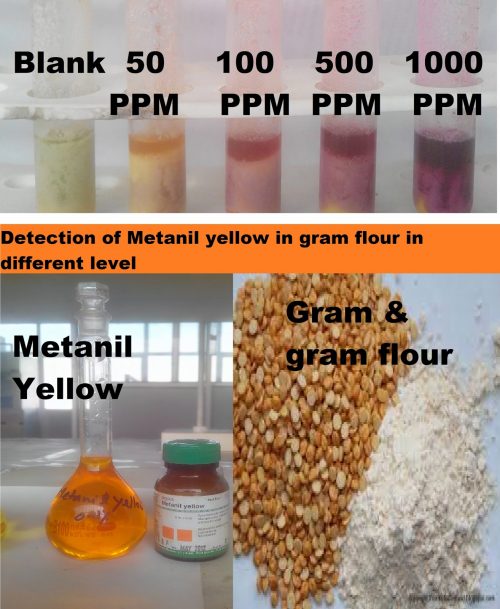
Adulterant: Metanil Yellow
Test: Powder some dal with a pestle and mix a spoonful of it with lukewarm water. The same can be done for besan. Add a few drops of hydrochloric acid to the mixture. If it turns pink or purple, it indicates the presence of metanil yellow.
8. Tea
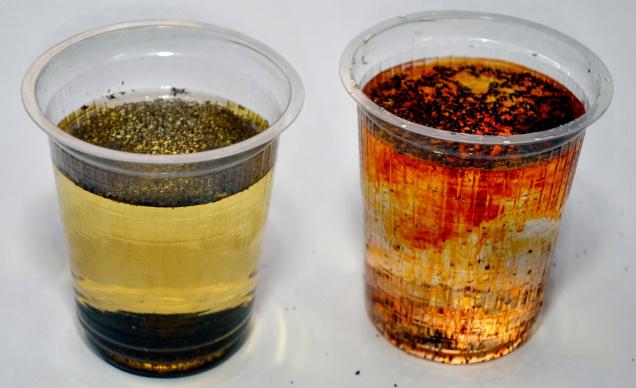
Adulterant: Used/processed tea leaves that have been artificially coloured
Test: Sprinkle a teaspoon of tea powder on a moist blotting paper. If the colour of the blotting paper changes to something similar to yellow, orange or red, it indicates the presence of artificial colour in the tea powder. Pure tea leaves release colour only when they are added to hot water.
9. Honey

Adulterant: Glucose/sugar syrup, high fructose corn syrup
Test: Add a spoonful of honey to a glass of water. If the honey disperses instantly, it indicates the presence of glucose/sugar syrup. Pure honey is denser and will instead sink to the bottom instead of dissolving instantaneously.
Another test involves mixing a tablespoon of honey, a little water and about 2-3 drops of vinegar together. If the mixture results in foaming, it indicates possible adulteration in the honey.
10. Green Peas, Green Chillies and Other Green Vegetables
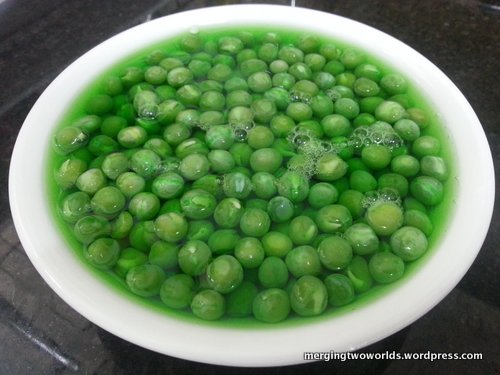
Adulterant: Malachite green
Test: Place a sample over a moistened white blotting paper. Green coloured impressions on the blotting paper indicate the presence of malachite green.
Take a cotton piece soaked in liquid paraffin and rub the exterior of the sample. If the cotton turns, green, it indicates the presence of the chemical dye.
Soak the sample in warm water for 30 minutes before rubbing it gently. If the green colour leaks into water, it indicates the presence of malachite green.
TBI Tip: For more of such do-at-home tests, check out the booklet released by the Food Safety and Standards Authority of India (FSSAI), an autonomous body under the Ministry of Health and Family Welfare.
You May Also Like: What’s in Your Food: All You Need to Know About Food Preservatives on the Labels
Like this story? Or have something to share? Write to us: [email protected], or connect with us on Facebook and Twitter.
NEW: Click here to get positive news on WhatsApp!
If you found our stories insightful, informative, or even just enjoyable, we invite you to consider making a voluntary payment to support the work we do at The Better India. Your contribution helps us continue producing quality content that educates, inspires, and drives positive change.
Choose one of the payment options below for your contribution-
By paying for the stories you value, you directly contribute to sustaining our efforts focused on making a difference in the world. Together, let’s ensure that impactful stories continue to be told and shared, enriching lives and communities alike.
Thank you for your support. Here are some frequently asked questions you might find helpful to know why you are contributing?


This story made me
-
97
-
121
-
89
-
167











